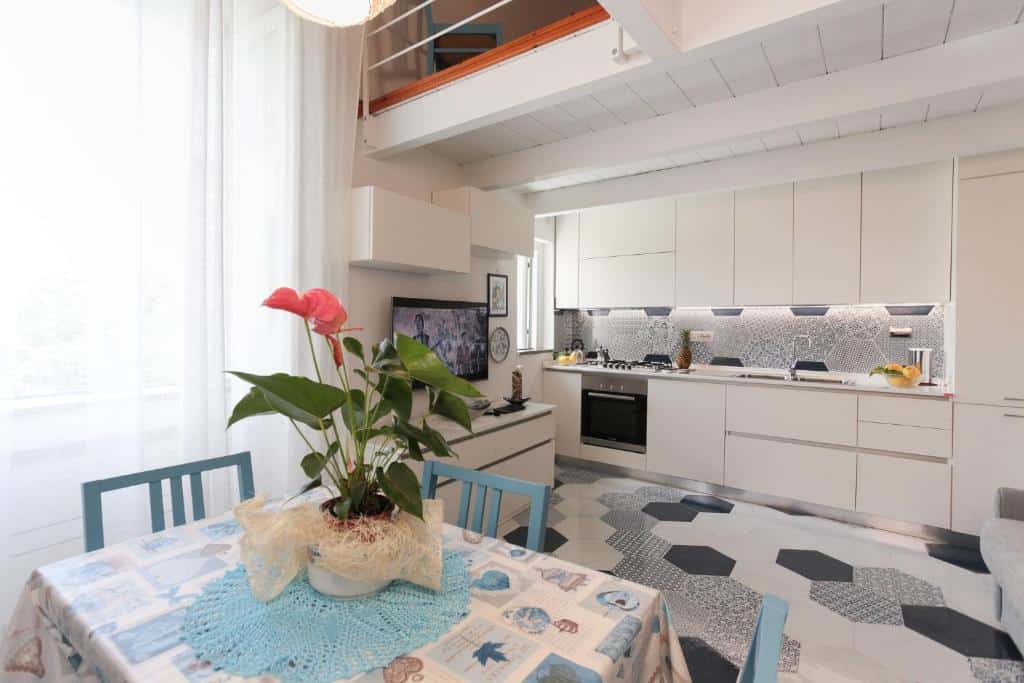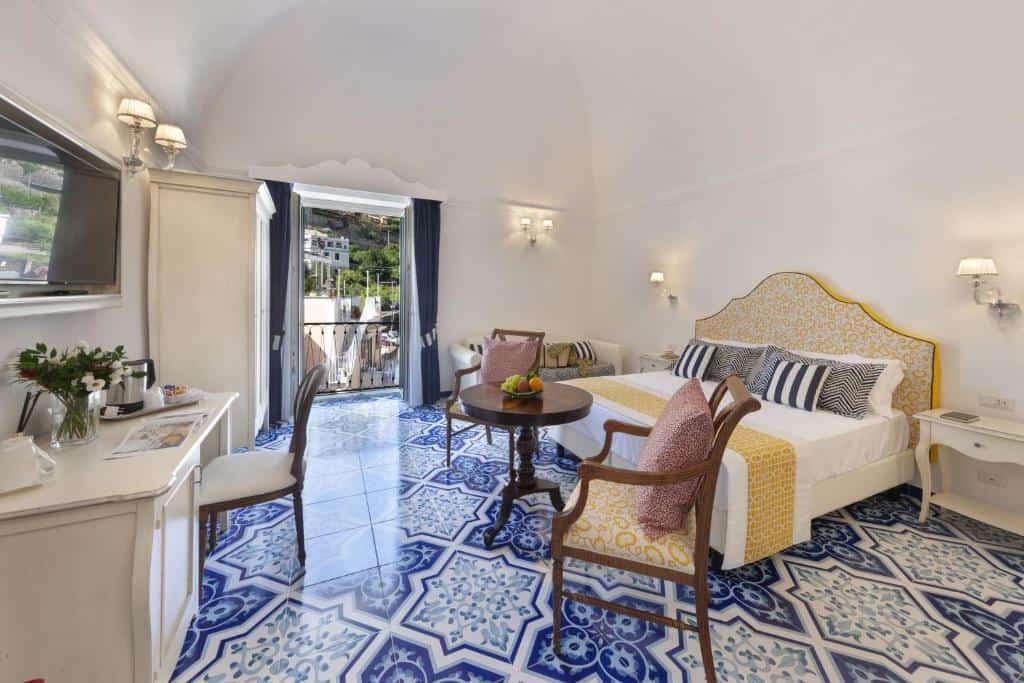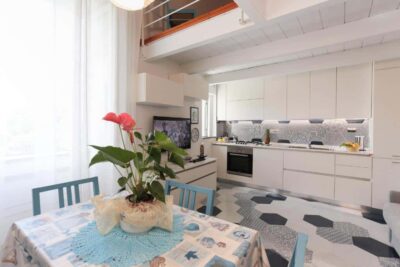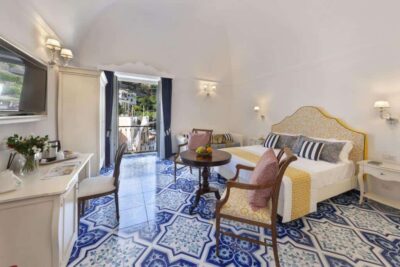Situated in a delightful and quiet cove between Capo d’Orso and Conca dei Marini, Minori is the Amalfi Coast town nicknamed as “the narcissus of the Coast” because of the uniqueness of its territory and the fertility of its land.
The enchanting landscape, enriched by the suggestion of historical memories and valuable medieval monuments and works of art, the small but comfortable beach provided with adequate bathing facilities, but above all the smell of orange blossoms, the taste of the sea and the mild climate turn Minori into a very renowned resort town.
Indice dei contenuti
How to get to Minori
✅ By Plane: Shuttle to P.zza Garibaldi (Naples).
Sita bus or train to Salerno and from there Sita bus to Amalfi and stop in Minori.
✅ By Car: A3 highway (Naples-Salerno).
Exit at Angri Sud and drive along the Valico di Chiunzi to Maiori and from there one km to Minori with the sea on the left.
ALTERNATIVE: Exit Vietri sul Mare, SS163 to Minori crossing the curves of the coast.
✅ By Train: Salerno train station. From Salerno to Minori by Sita Sud bus or Travelmar ferry.
📣 Your road free from queues: book the ferry!
If you’re looking for more information about getting from Minori to the other towns on the Amalfi Coast, download our free guide “How to get around the Amalfi Coast without stress” now: inside you’ll find lots of useful information for traveling comfortably during your trip, whether by car or public transportation!
Where to Sleep in Minori
📣 Book your hotel in Minori and Surroundings: we have selected the best ones for you!
What to see in Minori
📍 Roman Maritime Villa of the 1st century AD
a splendid example of an idyllic villa of the imperial era preserved in its structures and in part with its rich decorations. The Villa was discovered in 1932 and restored by the flood of ’54. On the lower floor, you will be able to visit the Viridaium, with in the center the pool surrounded by the triporticus, the triclinium-nifeo, around which the first floor with its mosaic floor is developed. On the upper floor, you can visit the Antiquarium, where a number of valuable artifacts are preserved
📍 The Basilica of Santa Trofimena
the town’s main religious monument, which dominates Cantilena Square. During the 19th-century restoration, the church lost its original Romanesque structure. In the nave, you can admire the large altarpiece of the “Cricifissione” by Marco Pino da Siena. The heart of the Basilica is, without a doubt, the crypt, where in an alabaster urn are kept the Saint’s relics, to which the locals are very devoted.
📍 The Church of Santa Lucia
a small 10th-century church restored in 1520 by a lay confraternity. Of particular interest are the wooden choir, the Baroque altar, also wooden, and the tomb of the founder, Giovanni Simone Palumbo, a Minoan nobleman who helped restore the church.
What to do in Minori
📣 Looking for the best experiences in and around Minori?
We have already selected them for you!
Trekking and walking
Minori, like so many towns on the Amalfi Coast, also offers the opportunity to enjoy healthy outdoor walks, going in search of splendid views, while being inebriated with the unmistakable scents of the Mediterranean scrub. Below is a list of the walks we recommend starting from Minori.
📍 The path of the Lemons

The approximately six hundred steps that connect the town of Minori to that of Maiori are a real journey into the past. This path is linked to the cultivation of lemons, which has always been a fundamental activity for the local economy. In ancient times the heavy baskets of lemons were carried on the shoulders or on the backs of mules.
If you venture out during the harvesting periods, which coincide with the months of June, July and August, you will be able to witness some of the stages of lemon cultivation or bump into some donkeys engaged in transporting the heavy baskets of lemons.
Find out all the information for your walk by reading our full article on the Lemon Trail.
📍 From Minori to the Convent of San Nicola, passing through the Auriola locality.
Start from Piazza Umberto and walk down the narrow street that takes you past the Roman Maritime Villa. Continue on Via Santa Lucia and then to Via Pioppi, where you can admire the ancient paper mills, near the Auriola locality.
From here you will cross an area rich in greenery and woods, until you reach the locality Forcella, the first settlement of the population of Minori. Finally you will reach the Convent of San Nicola.
Very suggestive is the path of the ancient paper mills, which can be reached through the driveway to the bottom of the Minori valley and then following the ancient path that winds towards the locality Auriola.
Experiences to do in and around Minori
Impossible not to recommend, among the first experiences, a stop at the famous pastry shop of master pastry chef Sal De Riso. where you can taste his most famous desserts, such as the delicious and timeless Ricotta and pears, or buy the now famous artisanal panettoni and colombe.
Impossible not to recommend other experiences, during your stay in Minori and on the Amalfi Coast: if you have time, devote a day to a boat trip, discovering the beautiful Emerald Grotto, or exploring the iconic Capri and Positano.
Minori is also famous for its lemon terraces: there are numerous agritourisms and accommodations that allow travelers to visit their lemon groves or offer tastings of dishes made with local products, as well as cooking classes, which will allow you to get in touch with the traditions of the Amalfi Coast, taking home the chance to replicate with your own hands the dishes you enjoyed during your vacation.
The villages of Minori
If you want to experience the atmosphere of times gone by, you must walk through the town, without hurrying.
We advise you to cross small streets, quiet alleys and stairways, to enter the heart of the town, going to discover its villages, where a special atmosphere suspended in time is hidden.
📣 It is enough to climb the many small uphill streets to reach the most characteristic corners of the town.
📍 Particularly pretty is the village of Villa Amena, with the ancient little church of San Gennaro,
📍 The village of Torre, which, with the church of San Michele, is the heart of the splendid “path of lemons,” which we mentioned earlier.
Unmissable events in Minori
✅ The celebrations in honor of Saint Trofimena, which occur on November 5 and 27 and July 13: the first date celebrates the discovery of the body, the second the discovery of the relics, and the third commemorates the translation from Benevento to Minori. The festival is deeply felt by the people of Minori, who celebrate the patron saint with performances, music and fireworks.
✅ Gusta Minori: an end-of-summer event – usually held on the first weekend of September – that mixes gastronomy, culture and entertainment. For the occasion, the most evocative places in the town provide a natural setting for music, theater and dance performances, while the waterfront comes alive with food stands, local and otherwise. For the occasion, Minoan restaurants and eateries prepare themed menus.
✅ The rites of Holy Week: on Thursday and Friday, a procession of beaters who, hooded in white and girded with rope, sing mournful songs winds through the streets of the town. The climax of the event is reached on Friday evening, when the town remains lit only by the light of flashlights and candles and the Dead Christ is carried in procession through the streets of the town.
Why choose Minori as your destination
Minori has preserved its original physiognomy and an authenticity of its own: it has its own almost whispered charm, which at first is almost imperceptible, but slowly makes its way inside you, until you begin to feel completely at home. While this makes it, perhaps, a less “iconic” and less celebrated destination on social networks, it also gives it a very special atmosphere and quietness.
📣 We believe you will love Minori if:
🔹 you are looking for a quiet place from which you can easily move to reach the other towns on the Amalfi Coast;
🔹 you are traveling with your family or small children: the town is small and cozy, never taken by storm by crowds and offers easily accessible beaches, both free and equipped.
The best time to visit Minori
We suggest you consider the spring period, especially in conjunction with Easter, so you can attend the rites of Holy Week and in particular the evocative Good Friday celebrations.
In this period you will have the opportunity to savor many typical Campanian specialties, which enrich the Easter tables, as well as find the ideal climate for many outdoor walks in and around Minori.
Another period to keep in mind is definitely the one that coincides with the end of summer: if you choose between the last decade of August and the beginning of September, you will visit Minori at the ideal time to enjoy the sea and the beach with more tranquility and you can also take advantage of it to participate in Gusta Minori, the most important cultural and gastronomic event in the town.
Interesting facts about Minori
✅ The tradition of handmade pasta Thanks to the abundance of water, coming from the valley, the establishment of mills and flour mills was favored. The town was not only famous, however, for flour production: starting in the 16th century, Minori was also famous for handmade pasta.
Important traces of this ancient tradition remain today in the traditional Minori dish the “ndunderi,” a type of fresh pasta, similar in shape to traditional gnocchi, but with ricotta added to the dough. We discuss this passionately in the article dedicated to the Minorese handmade pasta tradition.
✅ A viceregal tower If you look out from the dock, toward the small beach on the right, the tower you will find before your eyes will not go unnoticed: this is Torre Paradiso, a viceregal tower that was part of the defense system built over the centuries by the coastal inhabitants against Saracen and Corsican raids. Only the exterior facade of this tower remains today, as it houses a private residence.
The History of Minori
Minori was chosen by the Romans as a summer residence, as evidenced by the remains of a grandiose 1st-century AD maritime villa built scenically among the surrounding rocks and clearly visible from the sea.
After the destruction of the villa probably caused by frequent flooding, the place was probably abandoned for centuries. Tradition has it that the first inhabited nucleus of Minori was formed, around the fifth century, in a hillside location called Forcella chosen as a safe place by the inhabitants of the Sarno valley, fleeing from the incursions of Germanic peoples. The inhabitants of this first settlement, between the 6th and 7th centuries, founded a new maritime village that took the name Rheginna, which, in contrast to Maiori’s neighboring district, Rheginna Major, of greater extent, took the epithet Minor.
It is from this period that the remains of a Christian martyr were found on the beach and, therefore, the church dedicated to St. Trofimena, which, with Minori’s elevation to an episcopal see in 987, became Minori’s cathedral. This town, too, like the other towns on the coast, shared glories and honors with Amalfi, suffering the same fate with the decline of the Republic.
Minori was also unfortunately the victim of natural disasters; in 1492, 1528 and 1656 it was struck by terrible plagues that decimated the population. Thanks to the abundance of water and the fertility of its territory, Minori boasted, in the past, very flourishing industries, both paper and food. As early as the 13th century paper mills in Minori made rag paper, known as bambagina, which was widely used in courts and religious institutions. A particularly lively branch of activity was the preparation of alimentary pasta: mills and pasta factories formed the connective tissue of the small seaside village.
Minori’s history follows the events of the Kingdom of Naples and later of united Italy. the terrible flood of 1954 profoundly marked the life and urban transformation of Minori, seeing the birth of modern palaces and hotel structures that fortunately did not spoil the aesthetics and its characteristic appearance as a seaside village.










